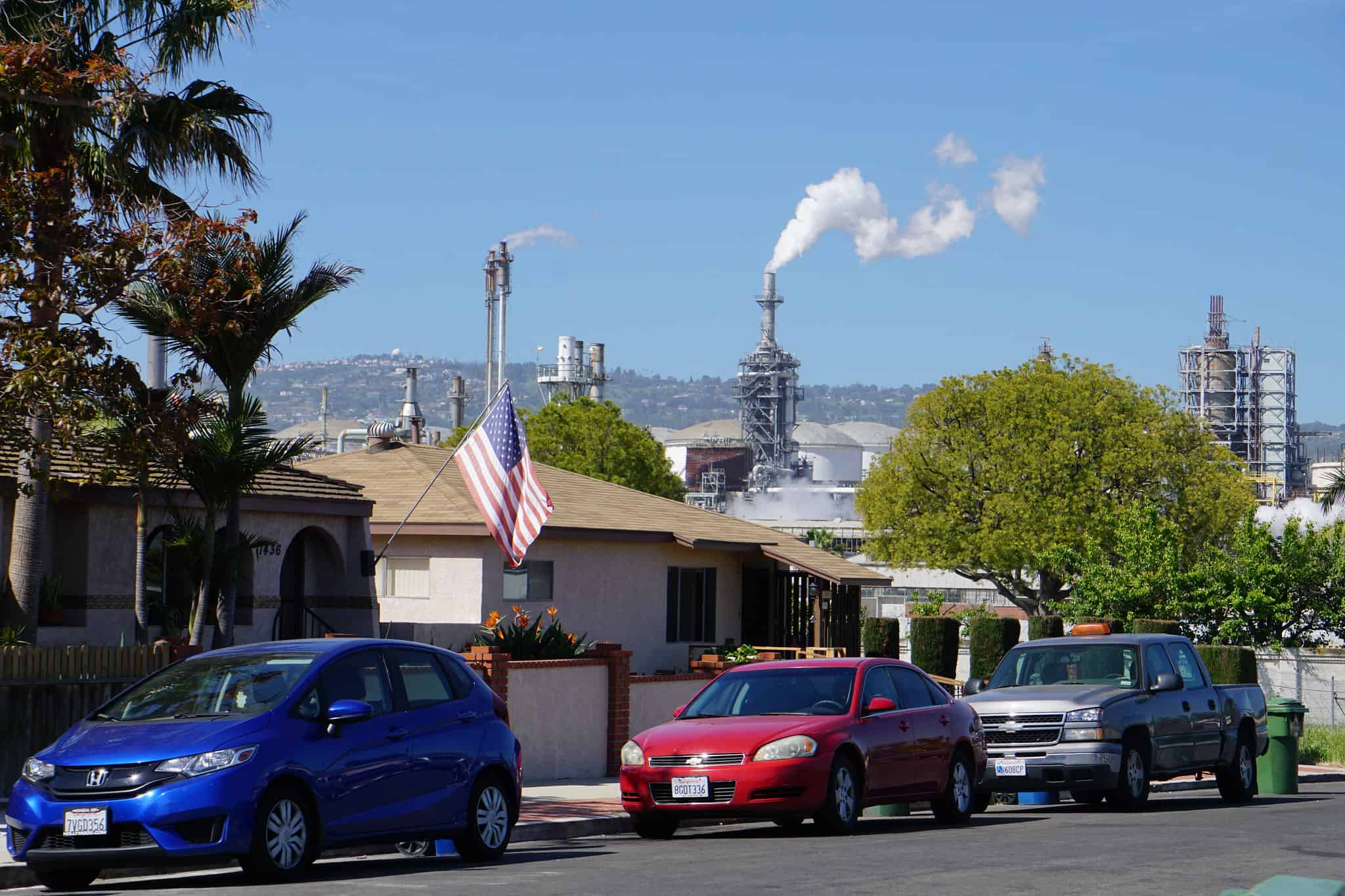Yet another US oil refinery will soon shut its doors. Phillips 66 announced in October 2024 that it will close its Los Angeles refinery by the end of 2025, due to factors that include declining oil demand and slim refining margins. An estimated 900 people are likely to lose their jobs when the refinery shutters.
Phillips 66’s decision to close its Los Angeles refinery comes after reports earlier this year that the corporation planned to divest from $3 billion of its assets. And the news continues the ongoing trend of refinery closures across the United States. Seven US refineries closed between 2019 and 2022, according to Sightline’s research. At least one other, in Houston, Texas, will shutter in 2025. More refineries will undoubtedly close as oil demand slows and then peaks, an event likely to occur before 2030.
Phillips 66 also owns a refinery in Ferndale, one of five in Washington state. News of the Los Angeles closure re-ups the urgency for Washington leaders to start a transition plan now for the future of the state’s refining communities.
Lawmakers have an opportunity with a forthcoming refinery study from the state Department of Commerce. Legislators who requested the study—and invested $250,000 of public funds in it—can make sure the final product hews to its original intent and helps set Washington up for a better, more resilient future: one with clean air and water for nearby residents and Tribes, support for refinery workers, economic stability and tax and employment diversification for towns and counties that host the state’s refineries, and a pathway to meeting Washington’s climate goals.
The Phillips 66 oil refinery has polluted Los Angeles’s Wilmington neighborhood for decades
In LA’s Wilmington neighborhood, where a Phillips 66 oil refinery has polluted for decades, 1 in 3 households includes a member with cancer, compared to the US average of 1 in 10.

Residents of Wilmington, the neighborhood in South Los Angeles where the soon-to-be-closed Phillips 66 refinery and several others are based, have breathed in the refinery’s toxic pollution for decades—and suffered the health consequences that come with that. Just one example: one in three Wilmington households includes a member with cancer, compared to the US average of one in ten.
The Phillips 66 refinery has spewed on average more than 1,000 pounds of chemicals every day into Wilmington’s air since 2000, including hydrogen cyanide, ammonia, and hydrogen sulfide, according to analysis by the environmental news outlet Grist. Unsurprisingly, then, many local environmental and community activists welcomed the news of the refinery’s closure, while expressing concern for the laid-off workers.

A “toxic tour” of Wilmington, California, organized in partnership with Communities for a Better Environment. Toxic Tour of Wilmington, CA by Emmett Institute used under CC BY-NC 2.0
Locals worry site will follow other shuttered refineries’ fates
Still, Phillips 66 has not yet announced what will come next for the site, leaving some residents concerned that pollution could continue.
“I hope that Phillips 66 doesn’t plan another polluting operation…continuing the trend of fossil fuels that are fueling the catastrophe of illnesses in the neighborhood and in the climate,” Alicia Rivera, an organizer with the California environmental justice group, Communities for a Better Environment, told LAist.
Sightline’s 2022 report on recent US refinery closures shows Rivera is right to be worried about what will come next. Four of the seven US refineries that closed between 2019 and 2022 converted to processing biofuels, in most cases with a sliver of their former workforce, no environmental remediation of the sites, and continued local pollution. Two refineries are keeping skeletal operations open to store oil or “idle” indefinitely, laying off almost all of their workers and shirking responsibility for environmental cleanup.
Only one of the seven, in Philadelphia, is being redeveloped entirely into a complex of e-commerce warehouses and life sciences buildings, which developers have branded the “Bellwether District.” Even so, some local residents, who, like those in Wilmington, have suffered from decades of toxic pollution, are concerned about the quality of ongoing environmental remediation efforts.

An artist’s rendering of a new “Innovation Campus” being built on the site of a former Philadelphia refinery. Source: PRNewswire, Hilco Redevelopment Corporation.
Another option for the Wilmington site is to replace the refinery with housing. “It’s a tremendous opportunity,” real estate analyst Jesse Gundersheim told the Los Angeles Times, indicating the site could be turned into a mix of housing, entertainment, athletic facilities and other purposes.
As unlikely as it may seem to build housing on a heavily contaminated site that, furthermore, is currently zoned for industrial uses, that’s exactly what happened after the Pacific Refinery in Hercules, California, closed more than 20 years ago. A development of more than 900 homes, called Victoria by the Bay, was completed in 2003 on top of the former refinery site after it was cleaned up.
A possible sign that housing is not off the table? Phillips 66 has engaged the same company that completed the Pacific Refinery redevelopment project to evaluate future uses of the site in Wilmington.

Victoria by the Bay, home of a former oil refinery in Hercules, California. Victoria by the Bay by gail used under CC BY 2.0
The opportunity for Washington leaders to prepare for future refinery closures
The question confronting Washington is not if one of its refineries will close, but when—and what comes next.
Thankfully, state leaders have an opportunity right now to start planning ahead to minimize the shock of sudden mass layoffs and safeguard Washingtonians from corporate handwashing of environmental and community responsibility. The Washington Department of Commerce is finalizing the state’s first-ever study that looks at the future of the five Washington oil refineries.
Sightline Institute, along with other Washington environmental groups, including Front and Centered, RE Sources, and Friends of the San Juan Islands, have offered our feedback on the draft study.
Here’s what we’re hoping to see in the final study, which the Department of Commerce will release to the legislature by the end of 2024:
- A full picture of Washington refineries’ environmental and health impact—and the environmental and health benefits of a future beyond oil. These impacts include air pollution, water pollution and the resulting toxins in fish and wildlife, health hazards to nearby communities, and the risk of an oil spill.
- A complete account of the current and past impact of refineries on Tribes. All of Washington’s refineries were built on Tribal land—the Swinomish’s, Lummi’s, and Puyallup’s. The refineries have tainted Tribal resources, including, but not limited to, local fish and shellfish, and land.
- An analysis consistent with Washington’s on-the-books climate laws. Washington’s statutory mandate to reduce greenhouse gas emissions to net zero by 2050—and other complementary climate policies, including the ramp-up of electric vehicles—will necessarily drive down oil demand and thus affect the economic viability of the state’s refineries. The study should reflect that reality.
- An interrogation of the feasibility and desirability of converting to biofuels refining. Biofuels conversion is the most common alternative oil corporations have chosen for recent shuttered oil refineries, but biofuels (like renewable diesel) are coming under increasing scrutiny for their environmental hazards, including the climate impact of turning forests and other carbon sinks into soybean and corn fields to grow feedstock and local air, water, and soil pollution from refining biofuels. Plus, with many oil companies across the United States and the world touting biofuels as their economic lifeline, the competitive position of all five of Washington’s refineries converting to biofuels is uncertain at best.
- A robust assessment of different future uses of the refinery sites. Examples of other refinery closures show there is no one-size-fits-all future for these contaminated sites. Options include housing, retail, open green spaces, a return to Tribal ownership, and industrial sites—with benefits and challenges to each. Washingtonians deserve to understand options for what could come next.
State legislators, who directed the Department of Commerce to undertake this study and invested $250,000 of public dollars into the effort, would be right to ensure the final product meets the above goals. If done well, the study can help lay the groundwork for a cleaner, more economically secure future, teeing up policy solutions and community-led deliberations about the future of the sites. In other words, it can mark the beginning, not the end—a smooth transition, not an abrupt drop off the cliff, as oil refining stops making sense in Washington.










